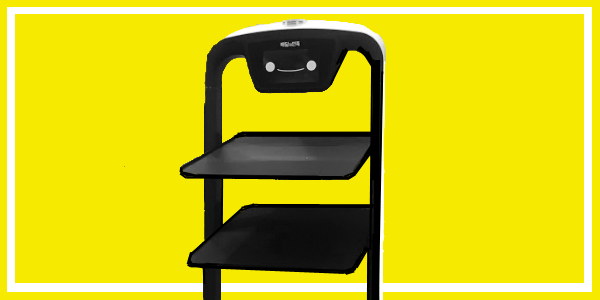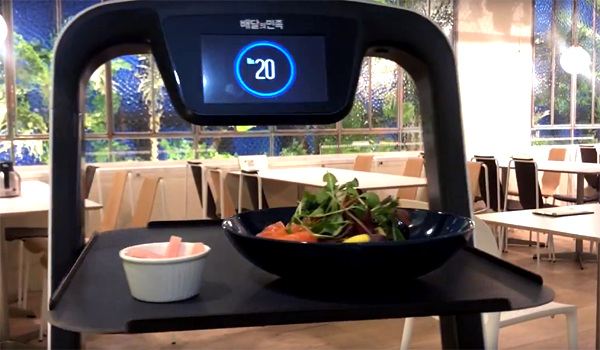
By Sunny Um WIRED Korea
A typical restaurant scene shows a waiter welcoming a customer with a smile and the customer, when seated, ordering his favorite dishes. If satisfied with the food, he may leave a tip on the table before he leaves. This is changing with the advent of robotics, artificial intelligence and other advanced technologies.
At some restaurants, diners can place orders using tablets, interactive kiosks or cell phones. That is not all; even robots are used as servers. But do robots work as well as human servers, or even better? Will all human servers eventually be replaced by robots? There should be many other questions concerning the use of robots as servers. In an attempt to catch a glimpse of what is happening, WIRED Korea met with "Dilly," a serving robot.
Dilly: At Your Service
Until recently, contact with robots has been confined to workers manning assembly lines. But robots are coming out of the factory and beginning to enter the outside world. And before long, they are certain to interact with people in all walks of life. An initial hiring of robots is found in restaurants and coffee shops.
Dilly – short for delicious – is a waiter robot manufactured by a food delivery application developer, Woowa Brothers. Since July, the robot has been working at Merry Go Kitchen in Songpa-gu, Seoul, a testing ground for Dilly’s abilities. Pulmuone and Culture, a restaurant chain, which has recently decided to hire two Dillys for its diners at Incheon International Airport and in Pangyo, Gyeonggi-do, will soon join Merry Go Kitchen in conducting robot feasibility tests.
First of all, Dilly is a workhorse. It can work for 24 hours without a break when fully charged. It can deliver up to eight dishes or 12 cups at a time. It is doing nearly 90 percent of all serving-related work at Merry Go Kitchen, according to Woowa Brothers.
Dilly is not a humanoid, but a functional self-driving robot. It has a display panel, and as many as four trays can be placed inside the body frame. Taking orders is not yet possible, however, leaving the job to customers, who must scan QR codes attached on the table with their smartphones in order to place orders. But the 82.7cm-tall robot makes sure to keep them satisfied by greeting them with a wide smile – albeit on its LED screen – when they enter Merry Go Kitchen.
Dilly can freely drive back and forth with no outside help. It has its own obstacle detector attached at the bottom – a Light Detection and Ranging (LiDAR) sensor, which is commonly used for three-dimensional mapping. This sensor gives Dilly an alert when a person or an object is in its path or as near as 40cm from it.
When the food is ready, Dilly carries it to the diner’s table. "The food you ordered has arrived, please enjoy," Dilly utters. The robot does not budge until the customer takes out the food from the embedded trays and presses the "Confirm" button on the display screen, or Dilly’s "face."
To ensure Dilly’s accuracy in delivery, nine markers, in the shape of fire alarms, are installed on the ceiling of the restaurant. "We had been working on self-driving robots before [developing Dilly]. Those robots had a margin of error of 30cm," said Kim Joseph, the head of Robot Delivery Cell at Woowa Brothers, in a phone interview with WIRED Korea. "To reduce it, we have placed markers on the ceiling. This has cut the margin of error to 10cm."
Moreover, Dilly is more efficient than a human server in some ways, said Kim. "For instance, it could carry heavier dishes [than a human server can]."
But it too has several shortcomings. It cannot take orders from diners, nor can it answer their questions. Its freedom of movement is severely curtailed when the floor is not flat or smooth. And with Dilly having no arms to serve food, diners themselves have to take it out of Dilly’s trays.
Dilly may be able to keep the job at some places though, catering to those who attempt to avoid human contact while shopping, banking or dining; it fits in with an emerging trend in South Korea called "untact," a term coined to denote minimal human contact by combining the prefix "un-" and the second syllable of "contact." An official from Pulmuone and Culture told Chosun TV that Dilly provides "an untact service minimizing human connection."
International Wave of Serving Robot
Dilly is not the only robot that is at the forefront of restaurant automation in South Korea. In April, a coffee-shop chain, Dalkomm Coffee, introduced its second generation of a barista robot named "B;eat." With the help of artificial intelligence and the 5G network, this robot receives vocal orders from customers, a job which its predecessors could not do. It can also display its emotions on the LED monitor screen.
The use of the robot makes sense, given that it is generating curiosity and boosting profits. The president of Dalkomm Coffee, Ji Sung-won, told News1 that his coffee shops with B;eat robots sell 10 times as much as his other shops managed by human servers.
Serving or cooking robots are found in other countries as well. In Japan, QBIT Robotics developed a collaborative robot arm for coffee shops. When a customer places an order, the mechanic arm makes a cup of coffee with the ingredients that are placed in the order of use. The four cameras affixed on the robot arm record the customer’s pattern of orders, gender, age, and other information, which are then saved to serve the client better next time.
In the U.S., two-armed Tipsy is fixing alcoholic and non-alcoholic drinks for customers, just like human bartenders would, while Flippy is flipping burger patties and placing them on buns once they are done cooking.
Loss of Human Jobs?
Automation in restaurants and other workplaces means job losses to many. If serving or cooking robots perform better than humans and their use costs less than the employment of human workers, they will certainly drive humans out of restaurants, as interactive kiosks have in shops in the past. This should be a cause of concern.
Job losses, however, may not be as severe as they appear to be, an expert predicts. True, jobs will certainly be replaced by robots as automation proceeds in restaurants and other labor-intensive workplaces. But technological advances create new jobs, making up for job losses resulting from automation, said Han Jaekweon, an assistant professor at the Department of Robotics at Hanyang University.
The use of robots in restaurants and coffee shops is in a testing phase. Moreover, they are so expensive that not many retailers can afford them. With the price of a B;eat robot, for instance, hovering around 100 million won, it will certainly take time until robots are widely used in restaurants.
But the undeniable fact is that robots have started to serve food and beverages. More restaurants will choose robots over humans for serving, when their prices go down. "What we would like to do is to lower the rental price [of the robot] to a level below the minimum wage rate," Kim said.



 뉴스레터 신청
뉴스레터 신청